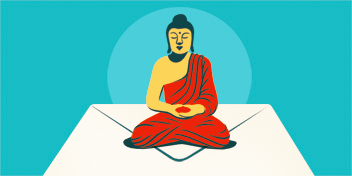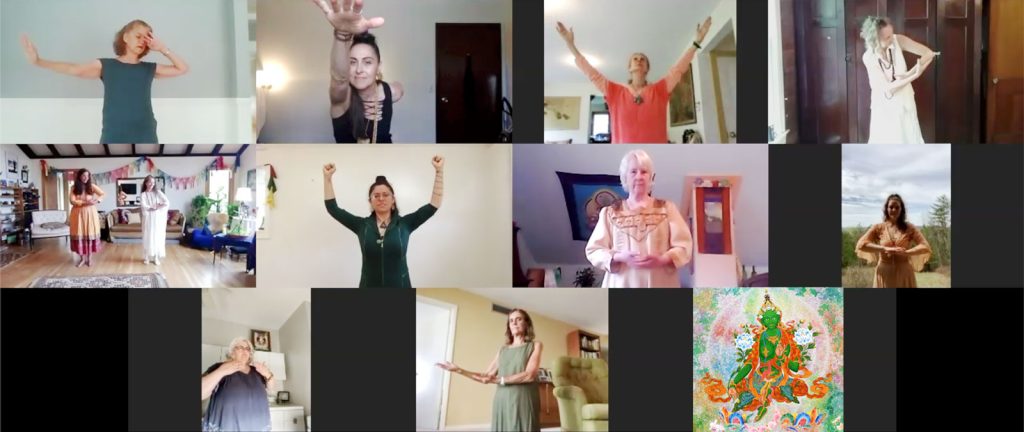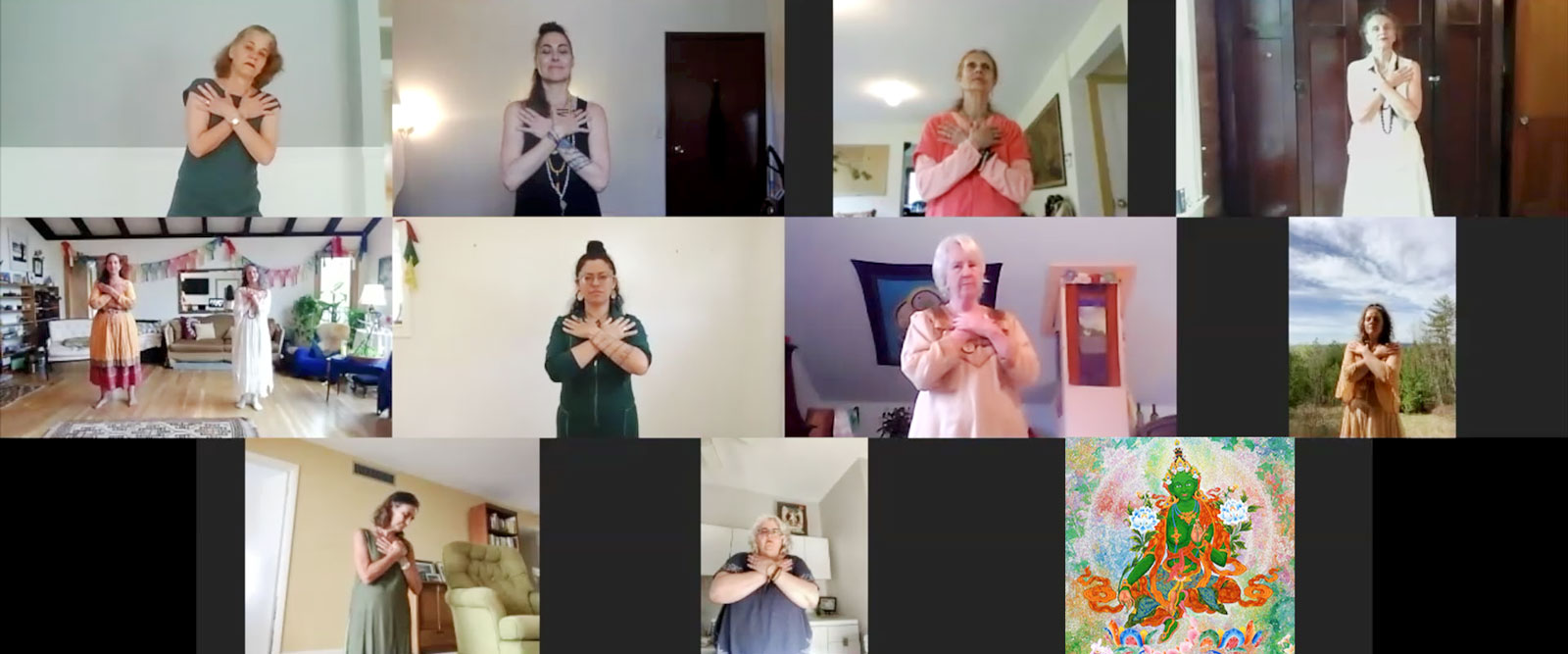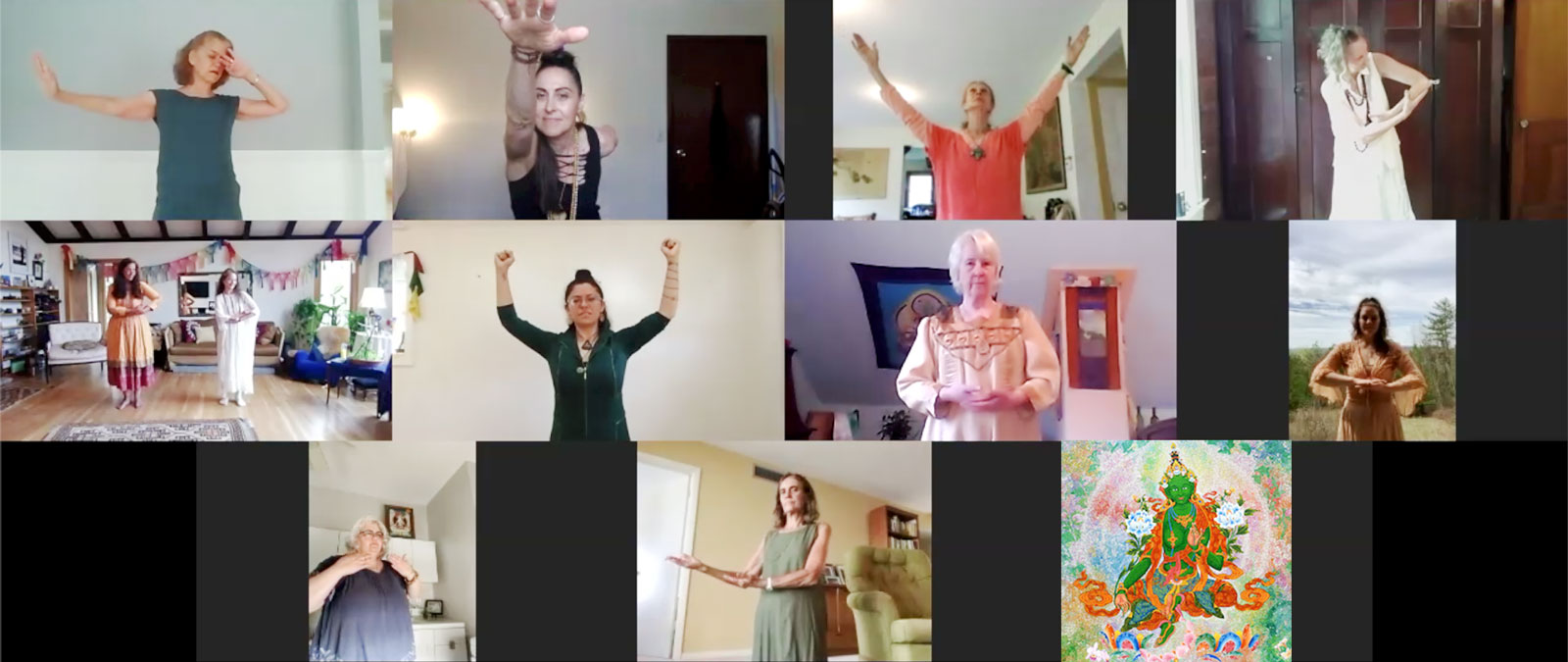My alarm clock urges me into semi-consciousness on my 53rd day of coronavirus quarantine. I am quickly reminded of my commitment to join via Zoom with a group of people, most of whom I have never met, to participate in my daily Buddhist practice—dancing Tara.
The dances are a sadhana, a Buddhist practice meant to help us embody a particular deity—in this case, Tara, a female buddha associated with wisdom and compassion as well as healing and protection. I learned the Tara Dances about a year ago from dharma teacher Prema Dasara, who generated them in 1985 with the blessings of her Tibetan lamas. Dasara travels the world teaching workshops that often culminate in a presentation of the dances to renowned Buddhist teachers, and has inspired the formation of new Tara Dance circles.
During this time of disease, unspeakable anguish, and multiplying difficulties, many spiritual teachers seeking to address suffering with teachings and meditation, both classical and inventive, have turned to Tara for inspiration—and to the webinar for means of communication. Likewise, the Tara Dances have moved online.
Since learning the Tara Dances, I had sporadically integrated them into my personal meditation practice, until COVID-19 and the shelter-in-place order forced me to spend the majority of my life isolated from regular contact. Faced with an undefined amount of unstructured time before me, I decided to perform this dance meditation every day. Then, at the start of quarantine, one of my fellow Tara dancers initiated a daily morning Zoom meeting for our practice. I wanted to support her creative effort and knew it would bolster my own, so I set my alarm.
During this pandemic, the idea of dancing may sound counterintuitive or even callous, but I have found incredible solace and strength in engaging in a daily practice of bringing the wisdom, compassion, and energy of Tara into my body, speech, and mind through dance. The practice launches my days with a sense of purpose, structure, and social connection─highly desired commodities right now.
The dance practice of Tara is an embodied deity yoga practice. The original meaning of the Sanskrit word yoga is “to yoke, or harness.” For millennia, before being redefined by the Western fitness industry, yoga indicated more broadly a spiritual discipline. In the Vajrayana, or Tantric Buddhist practice of deity yoga, one yokes oneself to, or unites with, a deity, an archetype of an enlightened divine being. The practice involves invoking, visualizing, and absorbing into oneself the deity in a meditative process designed to unlock the divine qualities residing inside ourselves. While deity yoga is often practiced in a sitting meditation posture, it is also practiced in the form of dance.
Sacred dance, or cham, has been used in Tantric Buddhist ritual for centuries. Our knowledge of its earliest performance goes back to the mid-eighth century, when the tantric master Padmasambhava (commonly known as Guru Rinpoche) brought Buddhism from India to the Himalayan region, and performed cham to subdue indigenous deities who opposed the new faith. Cham is designed to integrate the body (through movement and gesture), speech (through chanting mantra), and mind (through visualization) in a process of transformation into a compassionate, awakened being─a buddha. This embodied expression of the dharma, sacred dance, is an essential component of Himalayan Buddhist ritual.
Each morning we dance the choreography of the Dance of Tara’s Qualities, which is based on a popular Buddhist prayer The 21 Praises of Tara. The dance unfolds in sadhana form and incorporates meditation and visualization. The simple gestures and basic floor patterns are performed while chanting Tara’s mantra (Om Tare Tuttare Ture Soha) and reciting her 21 manifestations. (At Prema Dasara’s dance circles, she stands in the center—clad in her batik muumuu with her long silver tresses rippling about her shoulders—and beats a drum strapped around her torso as she calls out each line of Tara’s mantra for all to sing back in collective refrain.) These 21 manifestations are a distillation of the countless forms attributed to her—each with a different energy and virtue.
Tara is considered an emanation of the great goddess Prajnaparamita (Perfection of Wisdom), the mother of all the Buddhas. As such, she personifies transcendent wisdom─a concept expounded upon in a group of sutras that also bear this name, composed around the beginning of the first millennium. A central theme of the prajnaparamita teachings is the idea of emptiness, or shunyata. Emptiness, sometimes misunderstood as “nothingness,” actually describes a state of no fixed, separate, or default identity─hence, a dynamic state of limitless potential and relativity. The Dance of Tara’s Qualities actionalizes this teaching.
Our Tara practice begins as many Vajrayana practices do─with the three preliminaries: a statement of motivation, taking refuge (in the Three Jewels: the Buddha, the dharma, and the sangha), and the bodhisattva commitment to work for the enlightenment of all beings. We do this, however, with three opening dances.
We continue with the Dance of Tara’s Qualities, the centerpiece of our practice, during which the practitioner proclaims and dances each quality of Tara in an act of investigating it and absorbing it within herself. Some mornings I can’t imagine how I will move my body─much less dance Tara the Swift Protector. But I log into Zoom and feel a burst of joy as each grid box pops open to reveal the smiling face of a person who has made the effort to show up. Along with these fellow practitioners, I dance the forms of Invincible Courage (open chest with two uplifted arms to the sides clenching strong fists), True Refuge (a cradling motion), Transformer of Poison (forearms spin in front of the torso until fingers flick open as the hands and arms stretch away from the body), and Remover of Sorrow (right arm presses away from the body in a gesture of “stand back” followed by the left hand motioning as if to wipe sadness from one’s brow and press it away). In between the gestures of each quality, the dancer chants a refrain of Tara’s mantra while revolving around herself.
The dance concludes with a choreographed tonglen meditation. Tonglen is typically a stationary practice of visualizing oneself taking in the suffering of others and sending out light and love. Here, the dancers employ gestures and movement to physically send out compassionate and healing energy and gather in negative feelings (of the world or of a specific person) and transform them. As I move, I visualize negative energy transmuting into radiant light and lovingkindness. The dance session ends with a dedication of merit—the positive energy we have generated—to all beings.
This embodied practice encourages each dancer to internalize the confidence, dignity, and qualities of Tara’s essence. Dasara explains, “Sadhanas serve to stimulate and reorient our mind into awakened action.” The dance also encourages the practitioners to take this internally generated self-confidence and turn it outward─honoring and empowering each other like mirrors reflecting each dancer as an emanation of Tara.
When we dance and move our bodies in purposeful sequential patterns, the body responds by developing physical attributes such as strength, coordination, balance, agility, and endurance. “Every movement made and remembered shapes how an organism grows─what it senses and how it responds,” said scholar of religion Kimerer LaMothe in her essay “The Dancing Species: How Moving Together in Time Helps Make Us Human.” In other words, through physical movement we create the body with which we experience the world.
The thrilling connection occurs when the dynamic processes engendered by dance-meditation meet with the Buddhist understanding of the momentary nature of phenomena. This view proposes that when one observes change in a person or thing, it’s not that a fixed entity is passing through time and changing. Rather, at each individual moment, the entity is being replaced. We are a continuum of instants that are constantly being replaced. The physical and mental activity of dancing the Dance of Tara’s Qualities changes my mind and body, which then inform my internal states, activities, and social interactions from moment to moment. These inform future experiences of the dance, which then inform future internal states, activities and social interactions in a continuous course of change and transformation that reverberates outward.
Dasara’s guiding teacher, H. E. Tai Situ Rinpoche of the Karma Kagyu School of Himalayan Buddhism, declared the Tara Dances to be a cham of Tara’s lineage and a precious vehicle of enlightened mind. In response to his advice to protect the integrity of the practice, Dasara formed the organization named Tara Dhatu (the Pure Realm of Tara) and has created a robust teacher training program that provides training, guidance, and support materials for those who want to lead Tara Dance circles. These student-teachers have until now led live monthly gatherings in their communities worldwide. Since the COVID-19 order to shelter in place spurred the launch of the New York Zoom circle, other Tara circles have taken to Zooming at other times of day. The Tara Zoom screens are filled with people logging in from all over─from places as far away as Brazil, Canada, and New Zealand.
***
It is 8:15 AM. I join the rectangular grid, which is for now the new and beautiful shape of a Tara Dance Circle. As I begin the practice, I sense that moment of infinite potential and possibility. Then I plant my feet on the ground, and I dance and sing with a resounding “Om Tare!”
Photos and video by Amber Roniger
Thank you for subscribing to Tricycle! As a nonprofit, we depend on readers like you to keep Buddhist teachings and practices widely available.






